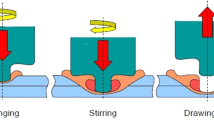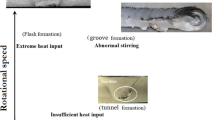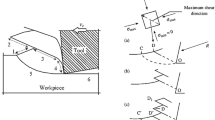Abstract
The objective of the research is to determine the effect of friction stir processing (FSP) parameters and vibration on the machining behavior of AZ91 alloy. The article displays the state of the art of AZ91 alloy machinability including chip formation, chip morphology, and cutting forces. In this method, the vibration was applied to the process line through the fixture under the workpiece during the FSP. The three-dimensional finite element (FE) modeling was applied for simulating the small-hole drilling process of AZ91 alloy. The large deformation of work and the chip formation in drilling process is realized by incorporating Johnson-Cook material constitutive model and material failure criterion. It was concluded that the microstructure from 150 (μm) for base metal was modified to 28 (μm) and 16 (μm) for FSP and FSVP samples, respectively. It has been indicated that mechanical properties increase as vibration applied during the FSP. The vibration improves adiabatic shearing and thus leads to more discontinuous chips. To enhance the mechanical and machining properties of processed zone the friction stir vibration process as an “easy to apply” FSP method is recommended for different industries.
















Similar content being viewed by others
References
Bagheri B, Abbasi M (2020) Development of AZ91/SiC surface composite by FSP: effect of vibration and process parameters on microstructure and mechanical characteristics. Adv Manuf 8(1). https://doi.org/10.1007/s40436-019-00288-9
Abdollahzadeh A, Shokuhfar A, Cabrera JM, Zhilyaev AP, Omidvar H (2019) In-situ nanocomposite in friction stir welding of 6061-T6 aluminum alloy to AZ31 magnesium alloy. J Mater Process Tech 263:296–307
Abdollahzadeh A, Shokuhfar A, Cabrera JM, Zhilyaev AP, Omidvar H (2018) The effect of changing chemical composition on dissimilar mg/Al friction stir welded butt joints using zinc interlayer. J Manuf Process 34:18–30
Abbasi M, Abdollahzadeh A, Bagheri B, Omidvar H (2015) The effect of SiC particle addition during FSW on microstructure and mechanical properties of AZ31 magnesium alloy. J Mater Eng Perform 24(12):5037–5045
Arab SM, Jahromi SAJ, Zebarjad SM (2016) The effect of friction stir processing by stepped tools on the microstructure, mechanical properties and Wear behavior of a mg-Al-Zn alloy. J Mater Eng Perform 25(10):4587–4597
Ramaiyan S, Santhanam SKV, Muthuguru P (2018) Effect of scroll pin profile and tool rotational speed on mechanical properties of submerged friction stir processed AZ31B magnesium alloy. Mater Res 21(3)
Dadashpour M, Mostafapour A, Yeşildal R, Rouhi S (2016) Effect of process parameter on mechanical properties and fracture behavior of AZ91C/SiO2 composite fabricated by FSP. Mat Sci Eng A Struct 655:379–387
Arora HS, Singh H, Dhindaw BK, Grewal HS (2012) Some investigations on friction stir processed zone of AZ91 alloy. T Indian I Metals 65(6):735–739
Asadi P, Faraji G, Besharati MK (2010) Producing of AZ91/SiC composite by friction stir processing (FSP). Int J Adv Manuf Tech 51(1–4):247–260
Hannard F, Castin S, Maire E, Mokso R, Pardoen T, Simar A (2017) Ductilization of aluminium alloy 6056 by friction stir processing. Acta Mater 130:121–136
Ahmadkhaniha D, Sohi MH, Salehi A, Tahavvori R (2016) Formations of AZ91/Al2O3 nano-composite layer by friction stir processing. J Magnes Alloy 4(4):314–318
Abbasi M, Bagheri B, Dadaei M, Omidvar HR, Rezaei M (2015) The effect of FSP on mechanical, tribological, and corrosion behavior of composite layer developed on magnesium AZ91 alloy surface. Int J Adv Manuf Tech 77(9–12):2051–2058
Dadaei M, Omidvar H, Bagheri B, Jahazi M, Abbasi M (2014) The effect of SiC/Al2O3 particles used during FSP on mechanical properties of AZ91 magnesium alloy. Int J Mater Res 105(4):369–374
Abbasi M, Abdollahzadeh A, Omidvar H, Bagheri B, Rezaei M (2014) Incorporation of SiC particles in FS welded zone of AZ31 mg alloy to improve the mechanical properties and corrosion resistance. Int J Mater Res 107(6):566–572
Abdollahzadeh A, Shokuhfar A, Omidvar H, Cabrera JM, Solonin A, Ostovari A, Abbasi M (2019) Structural evaluation and mechanical properties of AZ31/SiC nano-composite produced by friction stir welding process at various welding speeds. Proc Inst Mech Eng Pt L J Mater Des Appl 233(5):831–841
Palanivel R, Dinaharan I, Laubscher RF, Davim JP (2016) Influence of boron nitride nanoparticles on microstructure and wear behavior of AA6082/TiB2 hybrid aluminum composites synthesized by friction stir processing. Mater Design 106:195–204
Weglowski MS (2018) Friction stir processing - state of the art. Arch Civ Mech Eng 18:114–129
Padhy GK, Wu CS, Gao S (2015) Auxiliary energy assisted friction stir welding - a status review. Sci Technol Weld Join 20(8):631–649
Park K (2009) Development and analysis of ultrasonic assisted friction stir welding process, (doctoral thesis), The University of Michigan
Kumar S, Wu CS, Padhy GK, Ding W (2017) Application of ultrasonic vibrations in welding and metal processing: a status review. J Manuf Process 26:295–322
Liu XC, Wu CS, Padhy GK (2015) Improved weld macrosection, microstructure and mechanical properties of 2024Al-T4 butt joints in ultrasonic vibration enhanced friction stir welding. Sci Technol Weld Join 20(4):345–435
Strass B, Wagner G, Eifler D (2014) Realization of Al/mg-hybridjoints by ultrasound supported friction stir welding. Mater Sci Forum 783–786:1814–1819
Kumar SK (2016) Ultrasonic assisted friction stir processing of 6063 aluminum alloy. Arch Civ Mech Eng 16:473–484
Abbasi M, Givi M, Ramazani A (2019) Friction stir vibration processing: a new method to improve the microstructure and mechanical properties of Al5052/SiC surface nanocomposite layer. Int J Adv Manuf Tech 100(5–8):1463–1473
Gaitonde VN, Karnik SR, Siddeswarappa B, Achyutha BT (2008) Integrating box-Behnken design with genetic algorithm to determine the optimal parametric combination for minimizing burr size in drilling of AISI 316L stainless steel. Int J Adv Manuf Tech 37(3–4):230–240
Phadnis VA, Makhdum F, Roy A, Silberschmidt VV (2013) Drilling in carbon/epoxy composites: experimental investigations and finite element implementation. Compos Part A-Appl S 47:41–51
Huang D, Weißenfels C, Wriggers P (2019) Modelling of serrated chip formation processes using the stabilized optimal transportation meshfree method. Int J Mech Sci 155:323–333
Avevor Y, Vincent J, Faure L, Moufki A, Philippon S (2017) An ALE approach for the chip formation process in high speed machining with transient cutting conditions: modeling and experimental validation. Int J Mech Sci 130:546–557
Guu YH, Deng CS, Hou MTK, Hsu CH, Tseng KS (2012) Optimization of machining parameters for stress concentration in microdrilling of titanium alloy. Mater Manuf Process 27(2):207–213
Davim JP, Maranhão C (2009) A study of plastic strain and plastic strain rate in machining of steel AISI 1045 using FEM analysis. Mater Design 30(1):160–165
Özel T (2009) Computational modelling of 3D turning: influence of edge micro-geometry on forces, stresses, friction and tool wear in PcBN tooling. J Mater Process Tech 209(11):5167–5177
Maurel-Pantel A, Fontaine M, Thibaud S, Gelin JC (2012) 3D FEM simulations of shoulder milling operations on a 304L stainless steel. Simul Model Pract TH 22:13–27
Mao C, Zhou ZX, Ren YH, Zhang B (2010) Analysis and FEM simulation of temperature field in wet surface grinding. Mater Manuf Process 25(6):399–406
Wu HB, Jia ZX, Zhang XC, Liu G (2012) Study on simulation and experiment of drilling for titanium alloys. Mater Sci Forum 704:657–663
ASTM-E8M (2003) Standard test methods of tension testing of metallic materials, annual book of ASTM standards, vol 3.01. American Society for Testing and Materials, USA
ASTM-E112–13 (2013) Standard test methods for determining average grain size. ASTM International, West Conshohocken
Documentation, ABAQUS (2019) Dassault Systèmes Simulia Corp. Providence, RI, USA
Xia ZH, Chang-mei ZH, Li LI, Hong-jun H (2014) Numerical simulation of dynamic behavior of extruded AZ91D magnesium alloy based on SHPB experiment. Chine J Nonfer Metal 24(8):1968–1975
Abbassi F, Srinivasan M, Loganathan C, Narayanasamy R, Gupta M (2016) Experimental and numerical analyses of magnesium alloy hot workability. J Magnes Alloy 4(4):295–301
Rakhshkhorshid M, Mollayi N, Maldar AR (2017) A SVM model to predict the hot deformation flow curves of AZ91 magnesium alloy. Iranian J Mat Forming 4(2):15–24
Ng EG, El-Wardany TI, Dumitrescu M, Elbestawi MA (2002) Physics-based simulation of high speed machining. Mach Sci Technol 6(3):301–329
Özel T (2006) The influence of friction models on finite element simulations of machining. Int J Mach Tool Manu 46(5):518–530
Zorev NN (1963) Inter-relationship between shear processes occurring along tool face and shear plane in metal cutting. Int Res Prod Eng 49:143–152
Childs THC, Maekawa K (1990) Computer-aided simulation and experimental studies of chip flow and tool wear in the turning of low alloy steels by cemented carbide tools. Wear 139(2):235–250
Yao Z, Kim GY, Wang Z, Faidley L, Zou Q, Mei D, Chen Z (2012) Acoustic softening and residual hardening in aluminum: modeling and experiments. Int J Plast 39:75–87
Zerilli FJ, Armstrong RW (1987) Dislocation-mechanics-based constitutive relations for material dynamics calculations. J Appl Phys 61(5):1816–1825
Shi L, Wu CS, Gao S, Padhy GK (2016) Modified constitutive equation for use in modeling the ultrasonic vibration enhanced friction stir welding process. Scripta Mater 119:21–26
Fatemi-Varzaneh SM, Zarei-Hanzaki A, Beladi H (2007) Dynamic recrystallization in AZ31 magnesium alloy. Mat Sci Eng A-Struct 456(1–2):52–57
Bagheri B, Abbasi M, Abdollahzadeh A, Omidvar H (2019) Advanced approach to modify friction stir spot welding process. Met Mater Int. https://doi.org/10.1007/s12540-019-00416-x
Abbasi M, Givi M, Bagheri B (2019) Application of vibration to enhance efficiency of friction stir processing. T Nonferr Metal Soc 29(7):1393–1400
Darras BM, Khraisheh MK, Abu-Farha FK, Omar MA (2007) Friction stir processing of commercial AZ31 magnesium alloy. J Mater Process Tech 191(1–3):77–81
Bagheri B, Abbasi M, Givi M (2019) Effects of vibration on microstructure and thermal properties of friction stir spot welded (FSSW) aluminum alloy (Al5083). Int J Prec Eng Manuf 20(7):1219–1227
Bagheri B, Rizi AAM, Abbasi M, Givi M (2019) Friction stir spot vibration welding: improving the microstructure and mechanical properties of Al5083 joint. J. Metall, micro. Analys 8(5):713–725
Bagheri B, Abbasi M, Dadaei M (2020) Mechanical behavior and microstructure of AA6061-T6 joints made by friction stir vibration welding. J Mater Eng Perform 29(2). https://doi.org/10.1007/s11665-020-04639-7
Bagheri B, Abbasi M, Hamzeloo R (2020) The investigation into vibration effect on microstructure and mechanical characteristics of friction stir spot vibration welded aluminum: simulation and experiment. Proc Inst Mech Eng Pt C J Mechan. https://doi.org/10.1177/0954406219900194
Jafari M, Abbasi M, Poursina D, Gheysarian A, Bagheri B (2017) Microstructures and mechanical properties of friction stir welded dissimilar steel-copper joints. J Mech Sci Technol 31(3):1135–1142
Sunil BR, Ganesh KV, Pavan P, Vadapalli G, Swarnalatha C, Swapna P, Bindukumar P, Reddy GPK (2016) Effect of aluminum content on machining characteristics of AZ31 and AZ91 magnesium alloys during drilling. J Mag Alloy 4:15–21
Xiaohui N, Lijing X, Wenxiang ZH (2016) On the application of 3D finite element modeling for small-diameter hole drilling of AISI 1045 steel. Int J Adv Manuf Technol 84(9–12):1927–1939
Özel T, Zeren E (2007) Finite element modeling the influence of edge roundness on the stress and temperature fields induced by high-speed machining. Int J Adv Manuf Technol 35:255–267
Acknowledgments
The authors would like to thank the Amirkabir University of Technology (AUT), Sharif University of Technology and National Elites Foundation of Iran for their support during this research.
Author information
Authors and Affiliations
Corresponding author
Ethics declarations
Conflict of interest
The authors declared no potential conflicts of interest with respect to the research, authorship and/or publication of this paper.
Additional information
Publisher’s note
Springer Nature remains neutral with regard to jurisdictional claims in published maps and institutional affiliations.
Rights and permissions
About this article
Cite this article
Bagheri, B., Abdollahzadeh, A., Abbasi, M. et al. Effect of vibration on machining and mechanical properties of AZ91 alloy during FSP: modeling and experiments. Int J Mater Form 14, 623–640 (2021). https://doi.org/10.1007/s12289-020-01551-2
Received:
Accepted:
Published:
Issue Date:
DOI: https://doi.org/10.1007/s12289-020-01551-2




